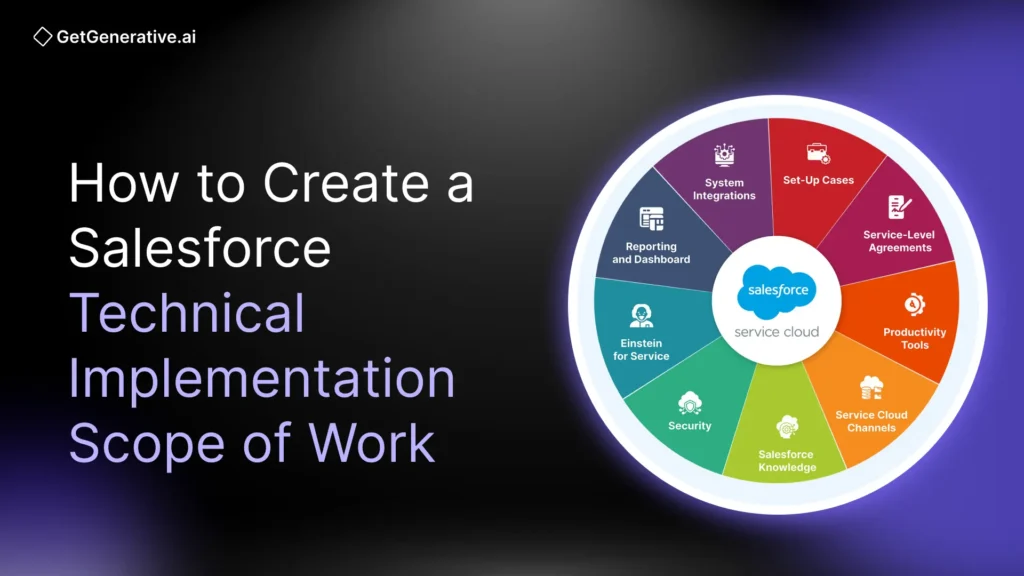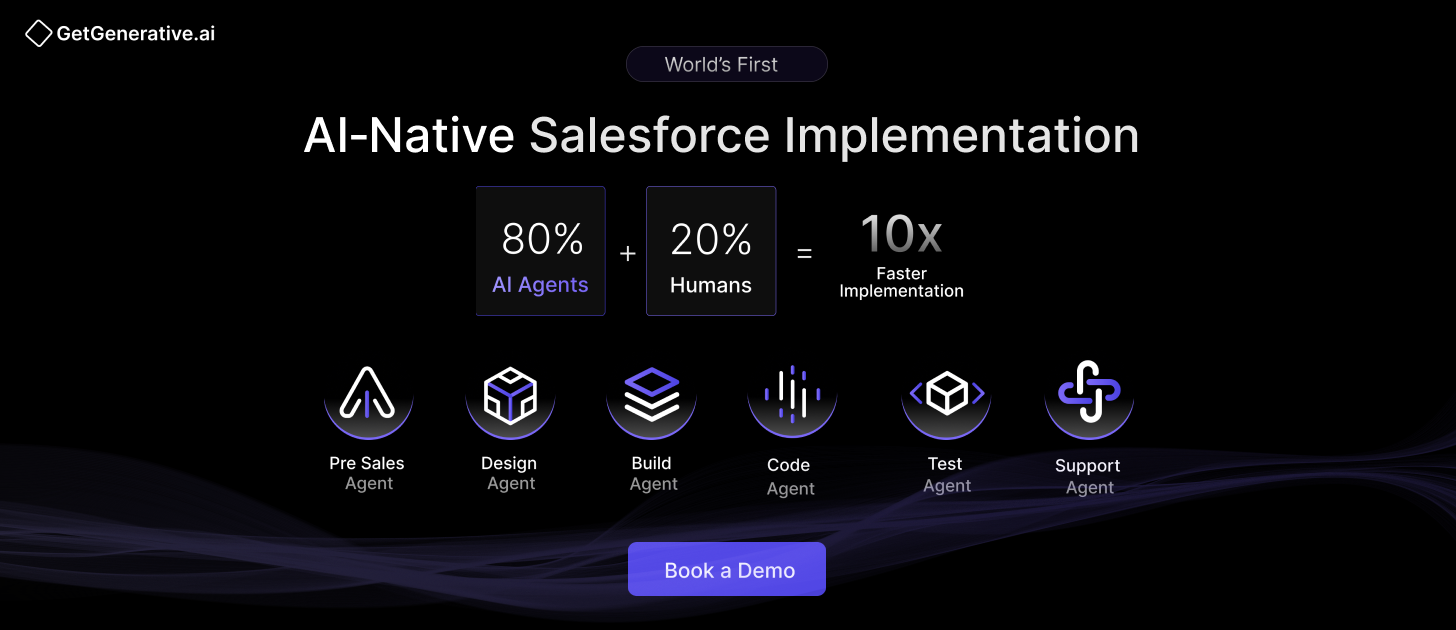How to Create a Salesforce Technical Implementation Scope of Work
A comprehensive technical scope of work (SOW) is the foundation of project success. It defines project boundaries, deliverables, risks, and expectations, ensuring all stakeholders align on measurable outcomes. Organizations with properly defined project scopes are more than twice as likely to succeed, and well-implemented CRM systems can deliver an average ROI of 245% within three years.
This guide provides a strategic framework and practical tools for creating Salesforce SOWs that maximize ROI, minimize risks, and drive higher adoption.
Why Scope Definition Matters
The High Cost of Failure
The consequences of weak scope planning are significant. Beyond the high implementation failure rate, organizations with poor scope management often face budget overruns of 60–70%. Timelines stretch far beyond the expected 4–10 weeks, sometimes extending into months. These delays often lead to low adoption rates, broken integrations, and diminished customer experiences.
The financial impact is equally alarming. Failed implementations frequently cause revenue losses of 15–25%, driven by poor data quality and disrupted operations. Adding to this, nearly half of employees report experiencing multiple abandoned projects, highlighting how weak project management undermines both financial and organizational performance.
The Business Case for Excellence
On the other hand, organizations that invest in strong scope definition see dramatically different outcomes. Well-planned implementations deliver:
- 38% faster decision-making
- 18.4% average revenue increase
- 35% improvement in customer satisfaction
- Over two times higher project success rates compared to poorly scoped projects
Companies that consistently document and define scope achieve success rates of 65% or more, compared to just 25% for those that neglect this step.
What Is a Salesforce Technical Implementation Scope?
A Salesforce technical implementation is the process of tailoring Salesforce through configuration, customization, and deployment to meet an organization’s unique requirements. Unlike basic out-of-the-box deployments, these projects often involve advanced integrations, compliance requirements, and custom code to ensure the CRM system aligns perfectly with business goals.
Key components of a technical implementation include:
- Requirements gathering and stakeholder alignment
- Solution design and technical architecture
- Standard configuration and customization
- Data migration and integration with legacy systems
- Apex programming and Lightning component development
- User interface customization
- Security and role-based access control setup
- Testing and quality assurance
- User training and adoption planning
- Deployment, go-live, and hypercare support
- Post-implementation maintenance and optimization
The Evolution of Complexity
Modern Salesforce implementations are significantly more complex than in the past. With Salesforce releasing three major platform updates every year, scope documents must balance detail with flexibility.
Key trends driving today’s implementations include:
- AI-powered functionality with Einstein GPT
- Multi-cloud deployments spanning Sales Cloud, Service Cloud, and Marketing Cloud
- Sophisticated integrations with SaaS ecosystems
- Increasing compliance and data security mandates
- Mobile-first design requirements for field sales and service teams
Also Read – Best AI Tools for Salesforce Proposal Generation
Core Components of an Effective Scope of Work
Executive Summary and Business Justification
The executive summary is the anchor of your scope document. It should communicate the business case, expected ROI, and strategic alignment in a way executives can quickly understand.
Best practices include:
- Setting quantified business objectives with measurable outcomes
- Presenting ROI projections using industry benchmarks
- Highlighting how the project supports broader business goals
- Summarizing risks and mitigation strategies
- Providing a high-level investment and timeline overview
Organizations that provide clear business justifications are far more likely to secure executive sponsorship and funding throughout the implementation lifecycle.
Detailed Scope Definition
The scope definition is the backbone of your SOW. It should carefully outline what is included and, just as importantly, what is excluded.
In-Scope Activities
Configuration and Setup:
- Salesforce org structure and hierarchy design
- User profiles, permission sets, and security roles
- Standard object customization and field creation
- Workflow rules, process automation, and flows
- Reports and dashboards
- Email templates and communication setup
Custom Development:
- Apex classes and triggers for advanced business logic
- Lightning components for user experience enhancement
- Custom objects and applications for unique needs
- API integrations for third-party systems
- Advanced reporting and analytics capabilities
Data Management:
- Data extraction, cleansing, and preparation
- Mapping and transformation specifications
- Migration testing and validation
- Governance frameworks for ongoing data quality
Integration Architecture:
- System connectivity and middleware design
- API specifications and security protocols
- Real-time versus batch integration strategies
- Error handling and monitoring processes
Out-of-Scope Exclusions
Defining exclusions is equally important to avoid scope creep, which affects nearly half of all Agile projects. Common exclusions include:
- Enhancements requested beyond the initial 90 days
- Integrations not identified during discovery
- Development for undocumented requirements
- Training for users outside the initial defined group
- Licenses and subscription fees for third-party apps
Technical Architecture and Requirements
This section sets the technical foundation for a successful project and requires close collaboration between business stakeholders and technical architects.
System architecture considerations include:
- Choosing the right Salesforce edition
- Sandbox strategies for development, testing, and staging
- Security frameworks, including SSO and IP restrictions
- API patterns, middleware requirements, and synchronization rules
- Performance metrics such as page load times and concurrent user limits
Additional technical specifications should address:
- Scalability for growth
- Disaster recovery and backup protocols
- Industry-specific compliance requirements
- Mobile responsiveness and accessibility
- Expected integration volumes and frequency
Implementation Methodology
The chosen methodology, like Agile, Waterfall, or Hybrid, defines how the project will be delivered.
- Agile: Provides iterative delivery, faster feedback loops, and adaptability. Projects using Agile show significantly higher success rates.
- Waterfall: Works best for projects with fixed requirements and regulatory-heavy environments that require detailed upfront documentation.
- Hybrid: Combines Waterfall’s structured planning with Agile’s flexibility. Many organizations now prefer hybrid models to balance predictability with adaptability.
A recommended Agile framework includes:
- Two-week sprint cycles
- Quarterly major releases and monthly minor updates
- Weekly demos and stakeholder reviews
- Bi-weekly retrospectives for continuous improvement
Also Read – Salesforce CRM Implementation With AI – The Ultimate Guide
Resource Requirements and Responsibilities
Successful Salesforce implementations require a diverse mix of skills, from executive leadership to technical expertise. Clearly defined roles prevent bottlenecks and ensure accountability.
Internal Resources
Executive Sponsorship
- Provides budget authority and organizational alignment
- Removes roadblocks and ensures strategic prioritization
- Leads steering committees for governance
Project Management
- Manages timelines, risks, and stakeholder communication
- Coordinates daily project activities
- Escalates issues and ensures delivery accountability
Business Analysis
- Gathers requirements and maps business processes
- Creates user stories and acceptance criteria
- Coordinates change management and training
Technical Resources
- Salesforce administrators for system management
- Data analysts for migration and testing
- Integration specialists for connecting third-party apps
External Consulting Support
Organizations often augment internal capabilities with Salesforce consultants. Rates vary significantly:
- Senior consultants: $150–200/hour for advanced customization
- Junior consultants: $50–100/hour for standard configurations
- Offshore consultants: $30–65/hour, offering 60–70% cost savings
Key consulting roles include:
- Solution architect for overall design
- Salesforce developers for Apex and Lightning components
- Data migration specialists
- Change management consultants for adoption strategies
Investment Planning and Budget Allocation
Budgeting is one of the most scrutinized aspects of Salesforce implementations. Costs typically range from $15,000 for small projects to over $500,000 for enterprise deployments.
Typical Cost Breakdown
- Consulting & Strategy: 25%
- Customization & Development: 30%
- Licensing: 20%
- Data Migration: 15%
- Training & Adoption: 7%
- Post-launch support: 3%
Small to Mid-size Implementations ($25,000–$200,000):
- 1–50 users
- Standard processes with moderate customization
- Limited integrations
Enterprise Implementations ($200,000–$500,000+):
- 50+ users across multiple business units
- Complex processes requiring deep customization
- Multiple integrations and data sources
- Large-scale training and change management
Hidden Costs to Consider
- Internal resource time for requirements and testing
- Change management efforts beyond basic training
- Data cleansing and quality improvements
- Extended testing cycles
- Ongoing optimization requests
Best practice: allocate 15–20% contingency to cover unexpected costs.
Risk Management and Mitigation Strategies
Comprehensive risk planning doubles the chances of success. Risks span both technical and organizational dimensions.
Common Technical Risks
- Data migration failures due to poor quality or complex transformations
- Over-customization creates maintenance headaches
- Integration breakdowns with APIs or third-party apps
- Performance issues under load
Common Organizational Risks
- User resistance, leading to poor adoption
- Lack of executive sponsorship
- Competing priorities rare educing engagement
- Resource shortages during critical phases
Mitigation Best Practices
- Engage stakeholders early and consistently
- Provide role-specific training and ongoing support
- Use phased rollouts to reduce complexity
- Conduct rigorous testing in sandboxes
- Establish escalation procedures and contingency plans
Success Metrics and Acceptance Criteria
Measurable success criteria provide an objective way to evaluate outcomes and ensure alignment with business goals.
Technical Acceptance Standards
- Page load times under three seconds
- 99.9% uptime during business hours
- Data accuracy rates above 98% post-migration
- Security and compliance requirements fully validated
Business Impact Metrics
- User adoption rates (login frequency, feature usage)
- Improved sales cycle times
- Higher customer satisfaction scores
- Revenue per lead improvements
- Reduced manual processes through automation
Organizations that set clear metrics are twice as likely to achieve desired outcomes.
Also Read – Top AI Tools Every Salesforce Developer Should Know in 2025
Advanced Scope Considerations for 2025
The Salesforce ecosystem is rapidly evolving. SOWs must account for emerging technologies and compliance landscapes.
AI and Automation Integration
- Data readiness for machine learning models
- Use case documentation for AI-driven automation
- Ethical AI considerations and bias monitoring
- Continuous improvement and retraining protocols
Compliance and Security Requirements
- Data privacy regulations like GDPR and CCPA
- Zero-trust security frameworks
- Audit trail requirements in industries like finance and healthcare
- Cross-border data transfer safeguards
Platform Evolution
- Incorporating Salesforce’s quarterly releases into planning
- Managing feature deprecations
- Lightning migration for legacy Classic users
- Multi-cloud integration strategies
Conclusion
Creating a Salesforce Technical Implementation Scope of Work is the foundation of successful delivery. The difference between failure and success often comes down to how well the scope is defined, communicated, and executed.
At GetGenerative.ai, we’ve reimagined Salesforce implementation—built from the ground up with AI at the core. This isn’t legacy delivery with AI added on. It’s a faster, smarter, AI-native approach powered by our proprietary platform.
👉 Explore our Salesforce AI consulting services




